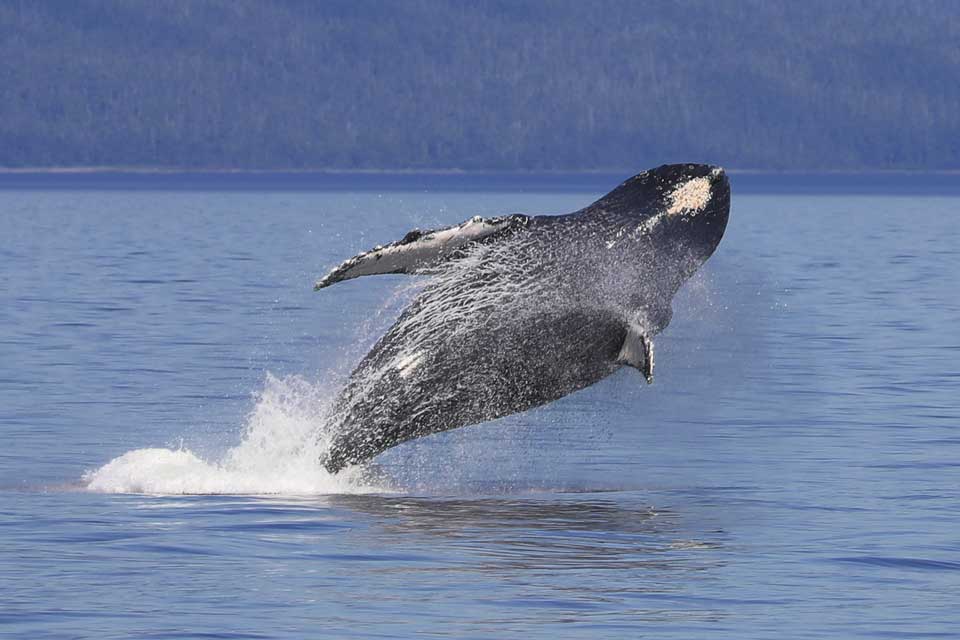Humpback whales occur in all oceans around the world and have one of the longest migrations of any mammal on the planet. Whales in the North Pacific can travel up to 5,000 miles from productive summer feeding grounds in Alaska to warmer breeding grounds in Hawaii or Mexico. In Southeast Alaska, the trip to Hawaii can take approximately one month.
Humpback whales are primarily black, but they have varying amounts of white on their pectoral fins, bellies and undersides of their flukes (tails). Tail fluke pigmentation patterns, in combination with scars and other distinguishing features, are unique to each animal and are used as “fingerprints” by researchers and naturalists for identifying individuals. Individuals are photographed and catalogued by researchers and naturalists to track them over time.
Humpback whales have two blow holes on the top of their heads. They also have bumps on their heads called tubercles, which contain a single hair that is a sensory tool like whiskers.
There are four distinct populations of humpback whales in the North Pacific:
The Mexico population, which breeds along the Pacific coast of Mexico and feeds in summertime mainly off the West Coast of the US but as far north as Alaska.
The Central America population, which breeds along the Pacific Coast off Costa Rica, Panama and Colombia and in summertime feeds off the West Coast of the U.S. and southern British Columbia.
The Hawaii population, which breeds in the Hawaiian Islands and feeds in the Aleutian Islands, Gulf of Alaska, Southeast Alaska and northern British Columbia.
The Western North Pacific population, which breeds in Japan and the Philippines and feeds in the North Pacific in the Bering Sea off the Russian coast and Aleutian Islands in Alaska.

Humpback whales derive their name from the distinctive hump on their backs. It’s scientific name, Megaptera, means “big-winged” and is inspired by its long pectoral fins, which can grow up to 16 feet wide (which is a third of their body length)!
All oceans of the world
Open seas and coastal waters. Many North Pacific humpback whales migrate annually for winter to Hawaii, Mexico and Central America to breed.
Plankton, krill and schooling fish such as herring
Humans
Humpback whales are commonly active at the surface and exhibit behaviors such as breaching (jumping out of the water), slapping the surface with their pectoral fins and tails, or lunging out while feeding. It is unknown exactly why they do these behaviors, but researchers think they could be for communicating, cleaning, or even play.
During the summer months, humpback whales spend most of their time feeding and consume up to 2,000 pounds of food per day. They filter-feed on small crustaceans such as krill by engulfing large amounts of water into their mouths and then filtering it through their baleen, trapping their prey. In Alaska, humpback whales use a unique cooperative behavior called “bubble net feeding” to feed on small fish such as herring. Whales communicate using sounds, create a net around schooling fish by blowing a curtain of bubbles around them to corral and trap them (fish will not swim through the bubbles), and then lunge upward through the net with their mouths open to engulf the prey.
Humpback whales sing complex songs that can be heard up to 20 miles away. Males may sing for hours by repeating a song several times. All males sing the same song with modifications, and songs evolve and change from year to year. Researchers think they are singing to attract potential mates.
In Frederick Sound, humpback whales can be heard communicating though a series of moans, grunts and cries while cooperatively bubble net feeding. It is thought that both males and females make these sounds.
Humpback whales also make sounds above water. Researchers speculate that breaching and slapping the surface with their tails and fins may be used to communicate with other whales over long distances.
Though they do not vocalize while breathing though their blowholes, some whales make distinctive trumpeting sounds while exhaling.
Breeding occurs in the lower, warmer latitudes. Humpback whales produce a single calf every 2 to 3 years after an 11 month gestation. Calves nurse for up to 1 year before weaning. Calves are not believed to maintain long term associations with their mothers, but they do frequent the same breeding and feeding grounds over their lifetime.
Humpback whales have been increasing in abundance across its range since a moratorium on commercial whaling 1985. But current threats from vessel strikes, entanglement, harassment, underwater noise and habitat loss remain.
Humpback whales were listed in the United States as endangered under the Endangered Species Conservation Act in 1970 and then under the Endangered Species Act in 1973. Currently four of the the 14 distinct population segments are still protected as endangered (including an North Pacific population that breeds in Central America), and one is threatened (a population that breeds in Mexico). All humpback whale populations in the United States are protected under the Marine Mammal Protection Act.